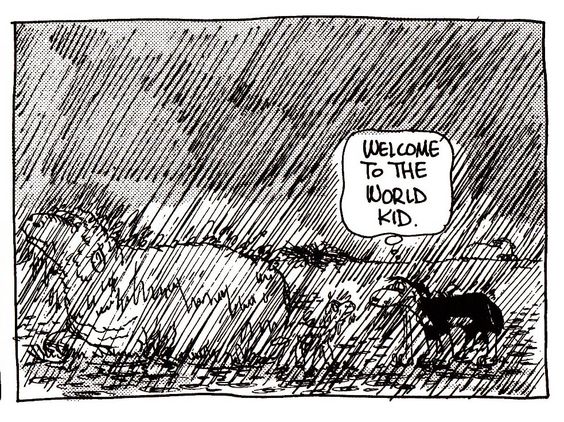How to get rid of Portuguese Millipedes - even during a plague
A frantic cry for help
Our neighbour rang the other day and left a rather frantic message. He was inundated with millipedes and was at his wits end. He's the sort of person who hates killing any living thing. Even millipedes. He reminds us a bit of 'Cooch Windgrass' from Footrot Flats by New Zealand cartoonist Murray Ball. We were over at 'Cooch's' place for a cuppa two weeks ago and he said he was tackling the millipede problem by just 'sweeping them up and putting them outside.' We looked at each other and wondered whether we were the only house in Tasmania that was suffering from this invasion of Portuguese millipedes and why we deserved it!
Then we got the message and smiled at each other. Not because we want our neighbour to suffer! But because a) we weren't going mad, b) it wasn't because of something we were doing wrong, as Townies new to farming.
A national problem right now
They are everywhere. They're making headline news all over the country. They're stinky, creepy, persistent little celebrities. They first appeared in Perth Western Australia. South Australia is the only state to have found a biological way to combat them, by introducing a parasitic nematode into the population. Here in Tassie we don't seem to have that option.
Just when you relax - KAPOW!
I have become something of an expert about handling these pesky beasties. After doing so well recently we became a little complacent with our ant dust. And then - KAPOW! They came back, like an army, marching into the house from every tiny crevice you can't even imagine. When I opened the front door I saw them, thickly coating it and the wall. Ugh!
It's mating season in autumn/early winter
That's why the buggers are so busy right now. They will be laying eggs too. So the population will spike later on. They can live up to TWO YEARS, going through many stages of development through moulting off their old body and eating it. (Ew....)
Importantly, they:
a) are attracted to light inside houses and
b) don't eat inside the house (unless its rotting)
How do you get rid of them?
Answer - you have to physically remove them and burn them. They curl up into a defensive position and their exoskeleton is extremely tough. I reckon they should be studied by the armed forces. And the stink! That too could be used to repel things, probably in agriculture. Even when they look dried up and withered lying there on the carpet and you think, 'Oh, it's dead' and then you go to vacuum it up and it starts wriggling like crazy.
They is tricksy.
So here are the steps that actually work. And it IS work, for you, so don't think you can use some half-baked, magic idea and get away with not doing much. It takes consistent effort.
If using commercial sprays isn't your thing, I just heard today that our neighbours Rob and Jane are pouring boiling water over their outside walls and using Borax as a powder deterrent. Tonight we gave it a go with the boiling water. We'll see what the result is tomorrow morning...
Don't stop, whatever you do
Whatever combination of the above you use, be consistent. After a while you will notice a drop in numbers. KEEP UP YOUR CAMPAIGN! This is the time that's most important. If you let down your guard the numbers will spike again. If it rains, the numbers will spike again. In Spring, they will start mating again. (groan) There is terrific information from the Australian Government here:
Good luck!
PS Vale Murray Ball, who died last year, the cartoonist who gave the world Footrot Flats. Always made me smile. Always made me think. Sorely missed.
Our neighbour rang the other day and left a rather frantic message. He was inundated with millipedes and was at his wits end. He's the sort of person who hates killing any living thing. Even millipedes. He reminds us a bit of 'Cooch Windgrass' from Footrot Flats by New Zealand cartoonist Murray Ball. We were over at 'Cooch's' place for a cuppa two weeks ago and he said he was tackling the millipede problem by just 'sweeping them up and putting them outside.' We looked at each other and wondered whether we were the only house in Tasmania that was suffering from this invasion of Portuguese millipedes and why we deserved it!
Then we got the message and smiled at each other. Not because we want our neighbour to suffer! But because a) we weren't going mad, b) it wasn't because of something we were doing wrong, as Townies new to farming.
A national problem right now
They are everywhere. They're making headline news all over the country. They're stinky, creepy, persistent little celebrities. They first appeared in Perth Western Australia. South Australia is the only state to have found a biological way to combat them, by introducing a parasitic nematode into the population. Here in Tassie we don't seem to have that option.
Just when you relax - KAPOW!
I have become something of an expert about handling these pesky beasties. After doing so well recently we became a little complacent with our ant dust. And then - KAPOW! They came back, like an army, marching into the house from every tiny crevice you can't even imagine. When I opened the front door I saw them, thickly coating it and the wall. Ugh!
It's mating season in autumn/early winter
That's why the buggers are so busy right now. They will be laying eggs too. So the population will spike later on. They can live up to TWO YEARS, going through many stages of development through moulting off their old body and eating it. (Ew....)
Importantly, they:
a) are attracted to light inside houses and
b) don't eat inside the house (unless its rotting)
How do you get rid of them?
Answer - you have to physically remove them and burn them. They curl up into a defensive position and their exoskeleton is extremely tough. I reckon they should be studied by the armed forces. And the stink! That too could be used to repel things, probably in agriculture. Even when they look dried up and withered lying there on the carpet and you think, 'Oh, it's dead' and then you go to vacuum it up and it starts wriggling like crazy.
They is tricksy.
So here are the steps that actually work. And it IS work, for you, so don't think you can use some half-baked, magic idea and get away with not doing much. It takes consistent effort.
- Clear away all rotting wood and leaf matter from around your house. This means ripping up untreated wooden barriers/garden edging. If you want this to end, you have to be prepared to change your place. So, to clarify, no wooden edging, NO MULCH, (you know, that lovely stuff TV presenters are always telling you to put in your soil to make things grow better? Yep, that stuff.) Dirt or lawn. Prune dead leaves off your plants too. Remove it all.
- Remove firewood from around your house. They LOOOOOVE hiding inside and under it. Makes them feel all cosy and romantic. And you don't want babies. These are neither cute nor cuddly.
- Buy kilos of ant dust. The best one we have found is Munn's. It's expensive, but it works more effectively than the other brands. Sprinkle a thick UNBROKEN line of ant dust round the perimeter of your entire house, directly onto the dirt where they emerge or the corner of the concrete/paving where the wall meets the ground.
- Buy boxes of surface spray and fly spray. Mortein works really well. You'll need to spray the ones on the ceiling, wait until they fall and then dispose of them.
- Put them in a bin where they can't crawl out. TIP: They can't crawl up shiny surfaces. I put them in a bin liner, in the pedal bin until I have a chance to burn them.
- THE MOST IMPORTANT STEP is to vacuum up all the wee beasties you can see every morning and every night before bed. During the day too, if you can. Every one that gets away is one that can breed more of them. Every one you capture can't breed.
- They stink when disturbed, so put carpet deodoriser on the carpet first to mask the smell before you vacuum. The orange goo they produce stains carpet so don't just spray and walk away. Don't step on them on the carpet.
- Burn them in a hot fire. DO NOT PUT THEM OUT IN THE RUBBISH BIN! They will just get away and keep going, spreading further.
- Buy lots of gap filler. Go around your house armed with gap filler and plug the holes they love to use as their highway. These things have a MEMORY. They remember where they came in and they try to go back out the same way. Don't let them. You can get clear gap filler for glass and painted walls or brown for wooden areas.
- Attach weather strips to all outside doors as a physical barrier to stop the endless march indoors. These have been really good at stopping them entering the house, but don't actually reduce the numbers outside.
- Pull down the blinds and shut the curtains at night to minimise light to the outside, as this attracts them.
- You can also use Teflon coated tape, light traps in the ground with 100mm sides, plate glass, an electric 'fence' using aluminium tape etc.
- Sprays with pyrethrum (made from a daisy and kinder to humans and pets) aren't really strong enough as surface sprays and must be sprayed directly onto the millipedes to work.
If using commercial sprays isn't your thing, I just heard today that our neighbours Rob and Jane are pouring boiling water over their outside walls and using Borax as a powder deterrent. Tonight we gave it a go with the boiling water. We'll see what the result is tomorrow morning...
Don't stop, whatever you do
Whatever combination of the above you use, be consistent. After a while you will notice a drop in numbers. KEEP UP YOUR CAMPAIGN! This is the time that's most important. If you let down your guard the numbers will spike again. If it rains, the numbers will spike again. In Spring, they will start mating again. (groan) There is terrific information from the Australian Government here:
Good luck!
PS Vale Murray Ball, who died last year, the cartoonist who gave the world Footrot Flats. Always made me smile. Always made me think. Sorely missed.






Comments
Post a Comment